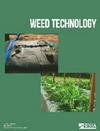Russian thistle (Salsola tragus) post-harvest control and plant dispersal
IF 1.7
3区 农林科学
Q3 AGRONOMY
引用次数: 0
Abstract
Russian thistle is one of the most important broadleaf weeds in the semi-arid US Pacific Northwest (PNW). It consumes soil water after wheat harvest, compromising the yield of the following crop. The objectives of this work were to determine the impact of post wheat harvest herbicide application timing on Russian thistle control, and stubble height on Russian thistle post-harvest control and plant dispersal. For the first objective, experiments were conducted at the Columbia Basin Agricultural Research Center (CBARC, Adams, OR) and the Lind Dryland Research Station (LDRS, Lind, WA) in 2020 and 2021. Herbicides evaluated included paraquat, glyphosate, and either bromoxynil + pyrasulfotole (CBARC) or bromoxynil + metribuzin (LDRS). The different post wheat harvest application timings were 24 h, 1, 2, and 3 wk after harvest. For the second objective, two stubble heights (short and tall) were compared for their impact on control at CBARC and in a production field near Ione, OR. Paraquat provided the greatest control in all scenarios, with no differences in application timings or stubble height. Impacts of application timings were not clear for glyphosate or bromoxynil mixtures. For glyphosate treatments, control in short stubble was 11% greater than in tall stubble in both years. Control was also greater in short stubble for the bromoxynil + pyrasulfotole in 2020. However, Russian thistle plant dispersal was greater in short stubble at both locations. At CBARC, plant dispersal in short stubble was 58% compared to 18% in tall stubble. Near Ione, plant dispersal in flattened stubble was 88% compared to 43% in non-flattened short stubble. Leaving tall stubble at harvest should be considered to reduce Russian thistle plant dispersal if the infestation is going to be left untreated after harvest. Otherwise, short stubble might result in better Russian thistle control when using systemic herbicides, such as glyphosate.俄罗斯蓟(Salsola tragus)收获后的控制和植物散布
俄罗斯蓟是美国太平洋西北半干旱地区最重要的阔叶杂草之一。它消耗小麦收获后的土壤水分,影响下一季作物的产量。本研究的目的是确定小麦收获后除草剂施用时间对俄罗斯蓟的控制,以及茬高对俄罗斯蓟收获后控制和植物扩散的影响。为了实现第一个目标,实验于2020年和2021年在哥伦比亚盆地农业研究中心(CBARC, Adams, OR)和林德旱地研究站(LDRS, Lind, WA)进行。评估的除草剂包括百草枯、草甘膦、溴腈+吡硫脲(CBARC)或溴腈+嘧霉嗪(LDRS)。不同的小麦收获后施用时间分别为收获后24 h、1、2和3周。对于第二个目标,在CBARC和俄勒冈州Ione附近的一个生产领域,比较了两种茬高(短和高)对控制的影响。百草枯在所有情况下都提供了最好的控制,在施用时间或残茬高度上没有差异。施用时间对草甘膦或溴苯腈混合物的影响尚不清楚。草甘膦处理在两年中,短茬比高茬的控制率高11%。2020年,短茬对溴腈+吡磺胺酮的控制也更大。然而,在两个地点,短茬的俄罗斯蓟植物扩散更大。在CBARC,短茬植物散布率为58%,而高茬植物散布率为18%。在伊奥内附近,植物散布在平整的短茬中为43%,而在未平整的短茬中为88%。如果在收获后不处理侵染,应考虑在收获时留下高茬,以减少俄罗斯蓟植物扩散。否则,当使用草甘膦等系统除草剂时,短茬可能会更好地控制俄罗斯蓟。
本文章由计算机程序翻译,如有差异,请以英文原文为准。
求助全文
约1分钟内获得全文
求助全文
来源期刊

Weed Technology
农林科学-农艺学
CiteScore
2.90
自引率
21.40%
发文量
89
审稿时长
12-24 weeks
期刊介绍:
Weed Technology publishes original research and scholarship in the form of peer-reviewed articles focused on understanding how weeds are managed.
The journal focuses on:
- Applied aspects concerning the management of weeds in agricultural systems
- Herbicides used to manage undesired vegetation, weed biology and control
- Weed/crop management systems
- Reports of new weed problems
-New technologies for weed management and special articles emphasizing technology transfer to improve weed control
-Articles dealing with plant growth regulators and management of undesired plant growth may also be accepted, provided there is clear relevance to weed science technology, e.g., turfgrass or woody plant management along rights-of-way, vegetation management in forest, aquatic, or other non-crop situations.
-Surveys, education, and extension topics related to weeds will also be considered
 求助内容:
求助内容: 应助结果提醒方式:
应助结果提醒方式:


